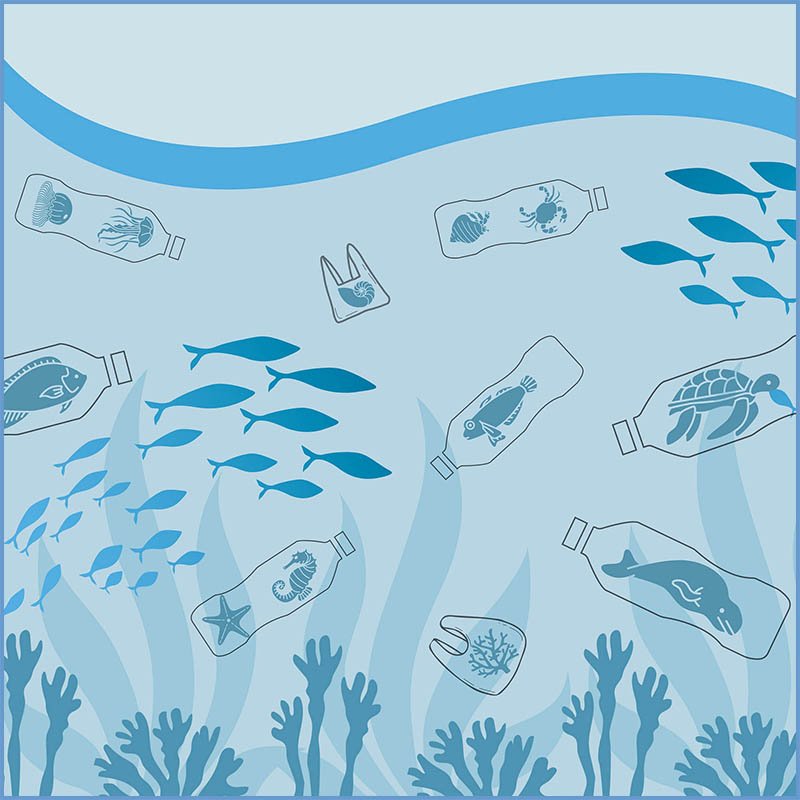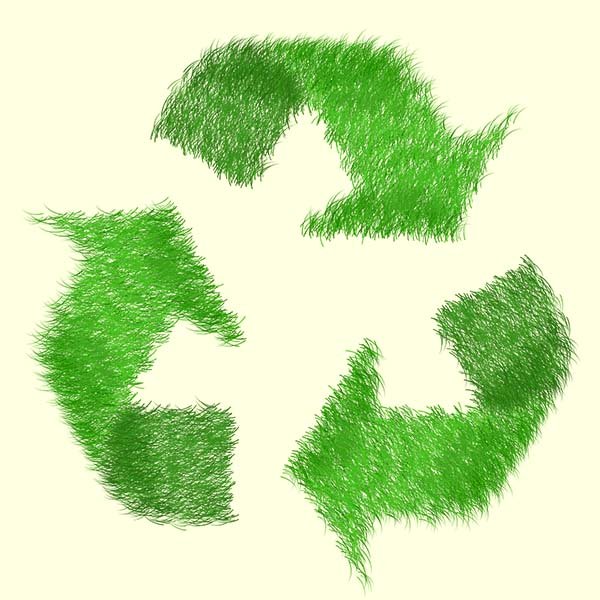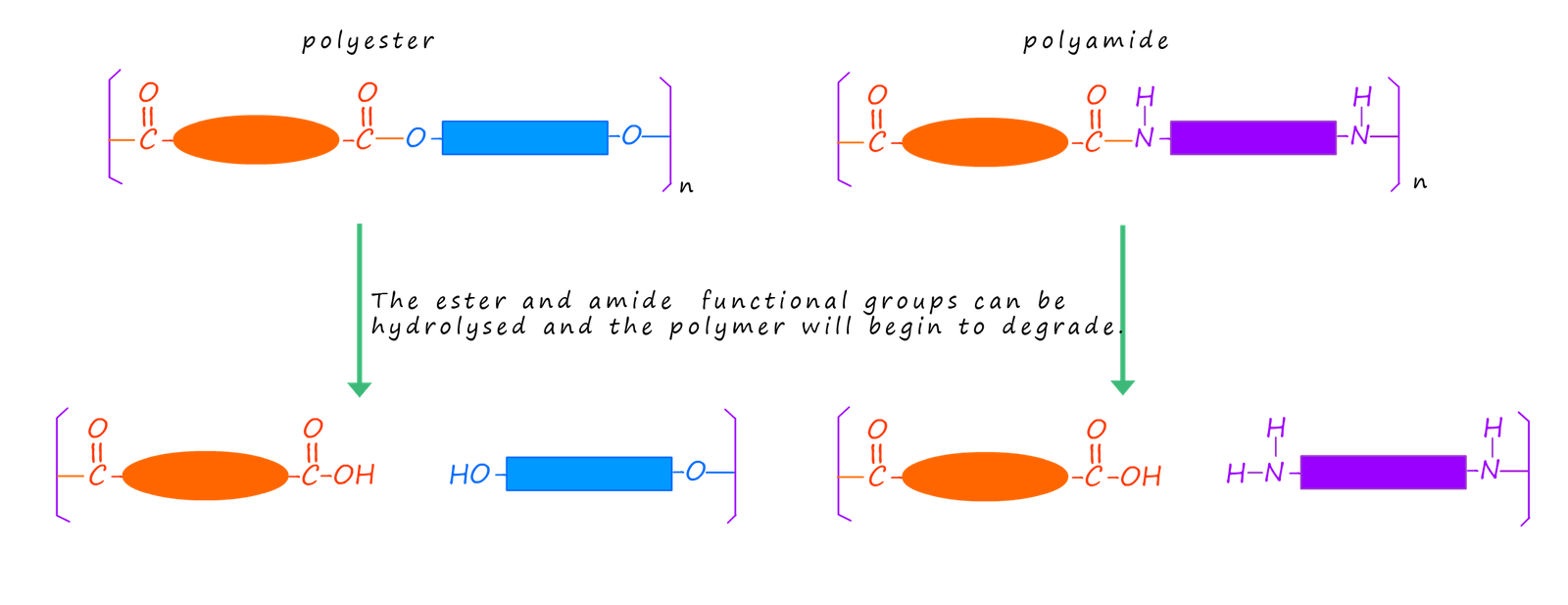


There cannot be many people who are not aware of the problems that the improper disposal of polymers or plastics is causing to the environment. As an example consider the plastic shopping bag. One of the main problems with polythene carrier bags is that they are treated as single use items. This leads to:

Another impact of plastic bags on the environment is that it can take up to 1000 years for them to degrade in a landfill site. Unfortunately many polyalkene plastics do not fully decompose in landfill sites but instead slowly degrade into smaller pieces called microplastics and nanoplastics. These microplastics have diameters in the range 1 μm—5 mm while and nanoplastics have diameters less than 1 µm. These microplastics are non-biodegradable and long lived so they are to able to spread all over the planet; they have been found in ecosystems as far apart as the Arctic Circle and Antarctica. These microplastics have been found in the zooplankton and phytoplankton. These organisms start many food chains and hence the microplastics have found their way up the food chain and into almost all marine organisms and habitats. Over 90% of all seabirds and fish have been found to contain some microplastics.
In addition toxic substances are released into the soil when plastic bags slowly degrade under sunlight and if plastic bags are burned they release toxic gases into the air causing atmospheric pollution. The issue of how to dispose of plastic bags has been an area of concern for many years across many countries. Some countries have banned the use of plastic bags and opted for bags made of biodegradable plastics while other countries have decided to charge a fee for the continued use of plastics bags in an attempt to try and reduce their use. However polythene bags are just one of over 65 000 plastics which are in everyday common use; with hundreds of millions of tons of new plastics objects being produced every year. So what are the options available to deal with the disposal of polyalkene plastics at the end of their life? The table below summaries the options available:
| Method of disposal | Advantage | Disadvantage |
|---|---|---|
| landfill |
|
|
| Incineration |
|
|
| Recycling |
|
|

Considering the many problems involved in disposing of polyalkene polymers when they reach the end of their life it may seem that the use of biodegradable plastics might solve many of the issues around the disposal of polyalkene polymers. Biodegradable polymers are capable of being decomposed in the environment by living organisms; usually bacteria and fungi. However this is by no means a quick process and can take between 50 to 500 years depending on the type of plastic.
Bioplastics are another type of plastics made from biomass; for example starch and cellulose unfortunately not all bioplastics are biodegradable
The use of these two types of plastics is increasing but they may not offer a complete solution to the problems associated with disposing of plastic waste. Some so-called biodegradable plastics only partly degrade in landfill sites to form microplastics; these microplastics can end up causing untold damage to natural ecosystems. The problem with many biodegradable plastics is that they are designed to be recycled in an industrial site which can carefully control the conditions to ensure the plastics decompose; these conditions are unlikely to be met in a landfill site which means it could require hundreds or even thousands of years for these plastics to actually degrade and decompose.
The term biodegradable is often used in advertising to promote an items green credentials, however it can be misleading as there is often no time limit to indicate how long the plastic will take to degrade and decompose; it could be weeks, months, years or even thousands of years. The term compostable plastic is often a little clearer in that a compostable plastic would be expected to decompose in a reasonable time scale, weeks or months not years.
However the timescale quoted for a compostable plastic to decompose will assume that it is composted at an industrial site, not in the natural environment. This will mean that these plastics will have to be collected and transported to an appropriate industrial site.
Many condensation polymers which contain ester and amide functional groups should in theory be biodegradable since these functional groups are found in many living organism and it would be expected that microbes; mainly bacteria and fungi; would be able to break up these plastics.

However many of these condensation polymers can still take decades or even hundreds of years to decompose in the natural environment.
While most commonly used polyalkene polymers such as polyethylene (PE), polypropylene (PP), polystyrene (PS) and poly(ethylene terephthalate) (PET) are chemically inactive and highly resistant to microbial attack and are therefore not biodegradable. However they are widely recycled and reused. The two common methods used to recycle plastics are mechanical and chemical processing. During mechanical processing the waste plastic is ground in small particles and cleaned; these particles can be then remelted and remoulded with or without fresh material being added to form the original product or a completely new one. During chemical processing the waste plastic is broken down to its component monomers by hydrolysis or pyrolysis. Recently biological methods using bacteria and enzymes to break up waste plastics have been developed are perhaps a promising development for the future recycling of waste plastics.
Bioplastics are plastics made from biomass such as starch and cellulose. However many of these bioplastics which are themselves biodegradable may have additives such as plasticisers added which are not always biodegradable. Bioplastics made from starch and cellulose are biodegradable but often some of these biodegradable plastics may be used as one of many components in a composite material where other materials present are not biodegradable. Composite materials are the most difficult to recycle simply because of the difficulties in separating out all the different plastics present. Even a simple composite plastic such as toothbrush would prove very difficult and uneconomic to recycle.